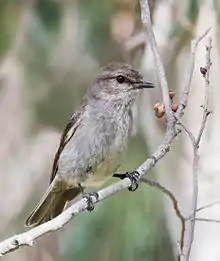Dusky robin
The dusky robin (Melanodryas vittata) is a small passerine bird native to Tasmania. A member of the Australian robin family Petroicidae, it is not related to robins of Europe and North America. It is a brown-plumaged bird of open woodland.
| Dusky robin | |
|---|---|
 | |
| Scientific classification | |
| Kingdom: | Animalia |
| Phylum: | Chordata |
| Class: | Aves |
| Order: | Passeriformes |
| Family: | Petroicidae |
| Genus: | Melanodryas |
| Species: | M. vittata |
| Binomial name | |
| Melanodryas vittata | |
Taxonomy
The dusky robin was described by the French zoologists Jean Quoy and Joseph Gaimard in 1832 based on a specimen that the authors mistakenly believed had been collected in "le port du Roi-Georges, à la Nouvelle-Hollande", but that had actually come from Tasmania. They coined the binomial name, Muscicapa vittata.[2][3][lower-alpha 1] It was known for many years as Petroica vittata before being placed in its current genus Melanodryas. Two subspecies are recognised, one on the Tasmanian mainland and the other on King Island. 'Stump robin' was a name given to it by early settlers from its habit of sitting on stumps or posts.[5] Other local names include 'wood robin' and 'sad robin'.[6]
The Australian robins were classified for a time in the Old World flycatcher family Muscicapidae or the whistler family Pachycephalidae, before being placed in their own family Petroicidae, or Eopsaltridae.[7] Sibley and Ahlquist's DNA-DNA hybridisation studies placed the robins in a Corvida parvorder comprising many tropical and Australian passerines, including pardalotes, fairy-wrens, honeyeaters, and crows.[8] However, subsequent molecular research (and current consensus) places the robins as a very early offshoot of the Passerida, or "advanced" songbirds, within the songbird lineage.[9]
Description
Measuring 16–17 cm (6.5–6.5 in) in length, the dusky robin lacks the bright colours of its robin relatives. The male and female are similar in appearance, with greyish- or olive-brown upperparts and narrow white shoulder edge,[10] and white patch on the wing. The throat is white and the underparts a pale brown. The feathers of the tail are brown with white edges. The bill is black, and the eyes and legs brown-black.[11]
Distribution and habitat
The dusky robin is endemic to Tasmania, where it is widespread. Its preferred habitat is open eucalypt forest and coastal heath.[5]
Breeding
The breeding season is from July to December, and one or two broods are raised. Placed in a fork in a tree or stump, often a fire-blackened one, the nest is a neat cup-shaped structure made of grass and bark, often only two or three metres above the ground. The clutch consists of two to four pale olive- to blue-green eggs, splotched with darker green and brown, and measuring 22 mm × 17 mm (0.87 in × 0.67 in).[12]
Notes
- Although the ornithological part of the Voyage de la corvette l'Astrolabe has 1830 on the title page, the book was not published until 1832.[4]
References
- BirdLife International (2012). "Melanodryas vittata". IUCN Red List of Threatened Species. 2012. Retrieved 26 November 2013.CS1 maint: ref=harv (link)
- Quoy, Jean; Gaimard, Joseph Paul (1830). Dumont d'Urville, Jules (ed.). Voyage de la corvette l'Astrolabe : exécuté par ordre du roi, pendant les années 1826-1827-1828-1829: Zoologie (in French). Volume 1. Paris: J. Tastu. pp. 173–174.
- Mayr, Ernst; Cottrell, G. William, eds. (1986). Check-list of Birds of the World. Volume 11. Cambridge, Massachusetts: Museum of Comparative Zoology. p. 567.
- Mlíkovský, Jiří (2012). "The dating of the ornithological part of Quoy and Gaimard's "Voyage de l'Astrolabe"". Zoological Bibliography. 2 (2&3): 59–69.
- Parks & Wildlife Service, Tasmania (7 July 2009). "Dusky Robin, Melanodryas vittata". Nature & Conservation. Department of Primary Industries, Parks, Water and Environment, Tasmanian Government. Archived from the original on 8 February 2011. Retrieved 12 July 2010.
- Fletcher, J.A. (1924). "Birds of the steppes". Emu. 24 (2): 107–17. doi:10.1071/MU924107.
- Boles, p. 35.
- Sibley CG, Ahlquist JE (1990). Phylogeny and Classification of Birds: A Study in Molecular Evolution. New Haven, CT: Yale University Press. pp. 603, 610–27. ISBN 0-300-04085-7.
- Barker, F. Keith; Cibois, Alice; Schikler, Peter A.; Feinstein, Julie & Cracraft, Joel (2004). "Phylogeny and diversification of the largest avian radiation" (PDF). PNAS. 101 (30): 11040–45. doi:10.1073/pnas.0401892101. PMC 503738. PMID 15263073. Retrieved 2008-08-14.
- Watts, Dave (2006) [1999]. Field Guide to Tasmanian Birds (2nd ed.). Frenchs Forest, NSW: New Holland Press. p. 155. ISBN 1-876334-60-6.
- Slater, Peter (1978). A Field Guide to Australian Birds: Passerines. Adelaide: Rigby. p. 172. ISBN 0-85179-813-6.
- Beruldsen, Gordon (2003). Australian Birds: Their Nests and Eggs. Kenmore Hills, Qld: self. p. 337. ISBN 0-646-42798-9.
